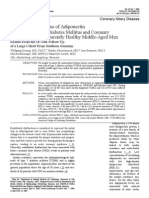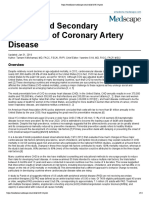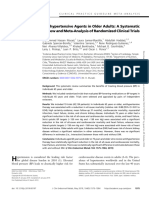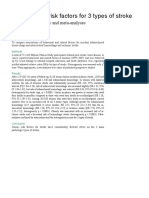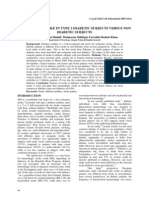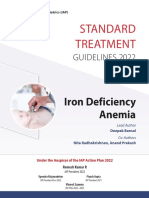Framingham Paper
Framingham Paper
Uploaded by
Likhna PertiwiCopyright:
Available Formats
Framingham Paper
Framingham Paper
Uploaded by
Likhna PertiwiCopyright
Available Formats
Share this document
Did you find this document useful?
Is this content inappropriate?
Copyright:
Available Formats
Framingham Paper
Framingham Paper
Uploaded by
Likhna PertiwiCopyright:
Available Formats
EPIDEMIOLOGY
A General Cardiovascular
Risk Profile: The Framingham
Study
WILLIAM
B. KANNEL,
MD,
FACC
DANIEL MCGEE TAVIA GORDON Bethesda, Maryland
Persons at high risk of cardiovascular disease can be effectively identified from a measurement of their serum cholesterol and blood pressure, a smoking history, an electrocardiogram and a determination of glucose intolerance. One general function for identifying persons at high risk of cardiovascular disease is also effective in identifying persons at risk for each of the specific diseases, coronary heart disease, atherothrombotic brain infarction, hypertensive heart disease and intermittent claudication, even though the variables used have a different impact on each particular disease. The 10 percent of persons identified with use of this function as at highest risk accounted for about one fifth of the 8 year incidence of coronary heart disease and about one third of the 8 year incidence of atherothrombotic brain infarction, hypertensive heart disease and intermittent claudication. Hence the function provides an economic and efficient method of identifying persons at high cardiovascular risk who need preventive treatment and persons at low risk who need not be alarmed about one moderately elevated risk characteristic.
Of the relatively lethal diseases afflicting populations in the industrialized world the cardiovascular diseases are by far the most common. In the Framingham Study, the chances of developing a cardiovascular disease by age 65 are 37 percent for a man and 18 percent for a woman. There is some interest, then, in identifying persons at special risk of having cardiovascular disease and in specifying the characteristics that put them at high risk. This paper describes a single risk function for predicting several different cardiovascular diseases and evaluates its efficiency in identifying persons most likely to have these cardiovascular diseases and consequently most in need of preventive care. Methods Since 1948 the Framingham Study has followed up a sample of 5,209 men and women residing in Framingham, Mass. with use of clinical examinations, conducted every 2 years, and continuous surveillance of morbidity and mortality. On each examination a variety of characteristics are measured, including blood chemistry values and blood pressure; an electrocardiogram is taken; and a thorough cardiovascular evaluation is made after obtaining a routine history and physical examination. To be considered at risk for cardiovascular disease a person must have been free at the start of the study of coronary heart disease, congestive heart failure, cerebrovascular disease, intermittent claudication and rheumatic heart disease. In the following discussion, cardiovascular disease refers to this set of diseases exclusive of rheumatic heart disease. The criteria and methodology for determining the set of variables and the various cardiovascular diseases discussed in this paper are given elsewhere.2 A logistic regression model for conditional risk is assumed, that is, the probability that disease will be manifested in a specified time period given a set of variables xi, x2, . . , xj measured at the first examination is assumed to take the form [l + exp - (ba + bixi + bsxs . . . bjxj)]- where bs, bi, bs, and SO forth are
From the National Heart and Lung institute, National Institutes of Health, Bethesda, Md. Manuscript received June 16, 1975; revised manuscript received August 15, 1975, accepted October 1.
1975.
Address for reprints: William B. Kannel, MD, Heart Disease Epidemiology Study, 123 Lincoln St., Framingham, Mass. 01701.
46
July 1976
The American Journal of CARDIOLOGY
Volume 36
GENERAL CARDIOVASCULAR
RISK PROFILE-KANNEL
ET AL.
constants to be estimated from the data. Estimation is by the method of Walker-Duncan.3 Standardized coefficients are obtained by multiplying each bi by the standard deviation of the variable xi with which it is associated. These may be used to judge the relative importance of each of the variables in estimating the probability of each specific disease.
Results
Risk Factors
Individual risk factors: Many host and environmental contributors to cardiovascular disease have been identified. These are of various kinds: atherogenic personal attributes (serum cholesterol level, blood pressure and glucose intolerance, for example); living habits that promote these traits (inactivity and overeating) or carry a direct cardiovascular risk (cigarette smoking); signs of preclinical cardiovascular disease (including electrocardiographic abnormalities, cardiac enlargement on X-ray film, other evidence of impaired cardiac function). Many of these factors are common in the American population (Table I). There is a large body of epidemiologic evidence from a variety of populations concerning the relation of these characteristics to cardiovascular disease, particularly coronary heart disease in men. The evidence is remarkably consistent, with few exceptions, that these characteristics do distinguish persons at high risk from persons at low risk.4 Although one might use any of these characteristics singly to separate high and low risk persons in a population, the efficacy of stich an approach would vary with the characteristic chosen and the cardiovascular disease for which risk was being assessed. The most useful single factor for detecting persons at high risk of cardiovascular disease would be blood pressure, since a large body of evidence indicates that it is the most potent ante-
cedent to the cardiovascular diseases discussed here, although it is not equally important for all of these diseases. Using blood pressure to screen for persons at high risk of stroke would be quite effective. Some 57 percent of the incidence of atherothrombotic brain infarction at Framingham arises in the 19 percent of the population having a systolic blood pressure of 160 mm Hg or greater. The statistics for hypertensive heart disease are similar. On the other hand, high blood pressure is antecedent in a much smaller proportion of cases of coronary heart disease and an even smaller proportion of cases of intermittent claudication. Overall, 36.2 percent of cases of cardiovascular disease occurring in a 2 year period arise in the group of persons whose systolic blood pressure is greater than 160 mm Hg.2 While there is some convenience in dichotomizing a continuous variable like blood pressure into high and low, one would prefer some method to take into account the exact value. Within the range of systolic blood pressure values that physicians usually consider to be within normal limits (perhaps 100 to 140 mm Hg) there is a two-fold range in the risk of cardiovascular disease proportional to the systolic level (Fig. 1). The same applies to serum cholesterol; here, too, risk is proportional to level and there is no critical value to indicate where normal ends and abnormal begins. Overall, a logistic curve (which implies a steady increment of risk with increasing level) seems to fit the data for serum cholesterol and systolic blood pressure fairly well and to provide a rational procedure for taking the exact level into account (Fig. 1 and 2). However, a single risk factor is neither a logical nor an effective means of detecting persons at high risk of cardiovascular disease. Screening efficiency can be considerably improved if other risk factors are taken into account. At any level of Mood pressure the risk of cardiovascular disease varies from less than average to
TABLE
Percent
I
Prevalence of Selected Risk Factors in the United States
Cigarette Smoking Men __Hypercholesterolemia
Age (vr)
Inactivity*
Obesity
Hypertension
Diabetes
ECG-LVH
35-44 45-54 55-64 65-74
12.1 16.9 21.0 27.1
12.5 14.7 12.5 12.7
13.5 18.3 22.3 27.1 Women
48.6 43.1 37.4 22.8+
1 .l 1 .l 3.3 3.2
20.2 25.7 23.5 21.6
2.9 4.8 10.1 7.1
35-44 45-54 55-64 65-74
l
13.3 19.3 30.8 39.0
20.1 24.2 30.9 27.2
8.5 18.2 31.2 47.6
38.8 36.1 24.2 10.2+
0.8 2.9 3.2 6.1
12.9 28.0 49.7 51 .o
0.9 3.6 4.1 9.6
Framingham, Mass. + Age 65 and over. Definitions: Inactivity is average oxygen consumption less than 0.30 liter/min (1954-58); obesity is weight 20 percent or more above median (1960-62); hypertension is a blood pressure at least 160/90 (1960-62); cigarette smoking refers to current habits (1970); diabetes is medically treated (1960-62); hypercholesterolemia is a serum cholesterol at least 260 mg/lOO ml (1960-62); ECG-LVH is an electrocardiogiaphic pattern of left ventricular hypertrophy (1948-53). Data for 1960-62 come from publications of the Health Examination Survey, series 11, numbers 14 (obesity), 13 (hypertension), 2 (diabetes) and 22 (hypercholesterolemia). Data on cigarette smoking are from the National Center for Health Statistics (unpublished).
July 1976
The American Journal of CARDIOLOGY
Volume 36
47
GENERAL CARDIOVASCULAR
RISK PROFILE-KANNEL
ET AL
many times average depending on associated characteristics (Fig. 3). Composite risk function score: The most efficient and sensible method of evaluating risk would appear to be to synthesize the major contributors to cardiovascular disease quantitatively into a composite score. This can be accomplished using a multiple logistic formulation that estimates the conditional probability of any major cardiovascular event for any set of risk factors (x), employing the actual level of each of the factors, their regression coefficients (6) and constants for the intercepts. A logistic function used this way has
come to be called a risk function. With the use of suitable risk factors, one can identify highly vulnerable persons who would otherwise be missed by arbitrary categorical assessment and can estimate the magnitude of their risk over a wide range for each of the major cardiovascular diseases. Among the various risk factors, an efficient set has been identified that, when synthesized into a risk function score, will select persons who are at high risk of coronary heart disease, atherothrombotic brain infarction, occlusive peripheral arterial disease and congestive heart failure. Using one set of coefficients for the
500
400 I c 8 300
Smoothed / /
$ 200 & z 3 ,z 5 ,@J_ 2 g w8070 6050 SBP 105 115 125 135 145 155 165 175 185 199 Level of Systolic Blood
Pressure
FIGURE 1 (left). Actual and smoothed probability of cardiovascular disease according to systolic blood pressure level: men and
, ; SC 169 183 199 213 229 243 258 273 299 303 327
Level of Serum Cholesterol
smoothed probability of cardiovascular disease (CVD) according to serum cholesterol level: men and women aged 45 to 64 years, Framingham Study.
700
_MEN
WOMEN
600
200-
IOOAVE.
RISk AVE. mii 335 0 0 0 336 t 0 0 336 t t 0 336 t t t I65 0 0 0 335 0 0 0 335 t 0 0 335 t t 0 336 t t t FIGURE 3. Risk of cardiovascular disease in 8 years at a systolic blood pressure of 150 mm Hg, according to intensity of other risk factors: Men and women aged 45 years, Framingham Study. AVE. = average: CHOL = serum cholesterol; CIG SMOK = cigarette smoking; ECGLVH = electrocardiographic evidence of left ventricular hypertrophy; GLU INTOL = glucose intolerance; SBP = systolic blood pressure.
43
ctia I65 6LU INTOL 0 a6 WOK 0 ECO-LVH 0
SOURCE: FRAMINOHAM MONOGRAPH NO. 26
48
July 1976
The American Journal of CARDIOLOGY
Volume 36
GENERAL CARDIOVASCULAR
RISK PROFILE-KANNEL
ET AL.
joint effect of these risk characteristics (including serum cholesterol, systolic blood pressure, glucose tolerance, electrocardiographic evidence of left ventricular hypertrophy and cigarette habit) it is possible to compute a risk function score. This can be done even though the variables used have a different impact on the incidence of each particular cardiovascular event. With these variables-which can be obtained atraumatically in an unprepared patient, at modest cost using ordinary office procedures and simple laboratory tests-and knowing the persons age and sex one can predict cardiovascular events over a 20-fold range from the lowest to the highest decile of risk in both sexes. In this way one can identify the 10 percent of the general population who will have 22 percent of the coronary heart disease, 31 percent of the occlusive peripheral arterial disease, 43 percent of the brain infarction and 40 percent of the congestive heart failure.
Variation by Disease
Although the specified variables are appropriate for cardiovascular disease in general, their individual roles vary from one disease to the other, and by sex (Table II).5 Whereas blood pressure is a major risk factor, it is distinctly more important as a precursor of brain infarction and heart failure than of coronary heart disease. Blood pressure is a minor factor, at best, in the background of persons with intermittent claudication, but cigarette smoking and glucose intolerance are major antecedents of this disease. Although cigarette smoking is an important factor in men for each of the four cardiovascular diseases cited, it tends to be a minor cardiovascular risk factor, overall, in women. The size of the standardized coefficients in Table II gives a reasonable approximation of the relative importance of each of the risk factors considered. (The data for serum cholesterol include an age constraint, since its role varies
with age, being greatest for young adults and decreasing with age. A similar variation by age exists for cigarette smoking, but it is less critical to allow for it in the estimates. Age, as such, is omitted from Table II since it is not a reversible characteristic.) Given this obvious heterogeneity of the regression coefficients among the various cardiovascular diseases it is fairly clear that it is less effective to use one risk function for all cardiovascular diseases than to use separate functions. However, it is obviously more practical to use a single function for cardiovascular screening provided the loss in efficiency in screening for persons at high risk for the specific diseases is not great. Screening for persons at high risk: The simplest and perhaps most immediately relevant way of comparing the relative efficacy of a specific and general estimate of risk is in the context of screening for persons at high risk. Suppose a risk function is used to identify the 10 percent of the population at highest risk. How many cases would be identified as falling in this group with use of a specific function for the disease and how many with use of a general function for all cardiovascular disease? To examine this question, the probability of each person at risk developing a specific disease was calculated and the population was then ranked from high to low according to this probability. To deemphasize the role of age, this ranking by level of risk was done separately for each 10 year age group and these age-specific populations were then ranked into deciles by level of risk. The actual number of events falling in each decile was counted. Ranking was done twice for each event, once using the coefficients for the specific event and once using the coefficients of total cardiovascular disease. As Table III shows, there is little to choose between these two methods of assignment; indeed, by chance, the general cardiovascular fit actually does better than the
TABLE II
Standardized Regression Coefficients for Incidence of Cardiovascular Disease for Specified Risk Factors: Men and Women Aged 35-64 Years (Framingham Study: 18 Year Follow-Up)
Coronary Disease Brain Infarction Men Systolic blood pressure Cigarette smoking ECG-LVH Glucose intolerance Serum cholesterolt 0.245 0.214 0.054 0.051 0.44 1 0.587 0.326 0.018 0.158 0.412 Women Systolic blood pressure Cigarette smoking ECG-LVH Glucose intolerance Serum cholesterolt
l
Risk Factors
Intermittent Claudication
Hypertensive Heart Failure*
Total Cardiovascular Disease
0.205 0.602 0.093 0.221 0.424
0.542 0.204 0.130 0.287 0.099
0.326 0.272 0.110 0.133 0.403
0.329 -0.087 0.068 0.102 0.391
0.478 -0.005 0.074 0.064 0.574
0.040 0.209 0.158 0.275 0.207
0.504 0.392 0.093 0.196 0.062
0.360 0.019 0.083 0.124 0.301
Congestive heart failure in the absence of coronary or rheumatic heart disease. t Regression coefficients for cholesterol at age 45. ECG-LVH = electrocardiographic evidence of left ventricular hypertrophy.
July 1976
The American
Journal
of CARDIOLOGY
Volume
36
49
GENERAL CARDIOVASCULAR
RISK PROFILE-KANNEL
ET AL
specific fit for atherothrombotic brain infarction although this finding should not be taken too literally. It, should be emphasized that this table is comparing a rank ordering of persons from low to high risk, not an assessment of the actual probability that the disease will occur. Any reasonable function will put a person at greater risk of having, say, atherothrombotic brain infarction if his blood pressure is higher than if it is lower. A multivariate risk function, of course, may assign a somewhat higher or lower rank to persons with a given constellation of characteristics depending on the weights (coefficients) used, but rank is not especially sensitive to variation in the coefficients. It may be argued that in some instances the apparent difference in coefficients among the specific cardiovascular diseases may be due more to random variation because of the small number of cardiovascular events available for estimation than to substantive differences. In those instances the coefficients for total cardiovascular disease should, in principle, be preferred to the coefficients estimated for the specific disease. However, this is an academic point in the absence of a method for
deciding between the two sets of coefficients in specific instances. Using the logistic risk functions for each specific cardiovascular cause one can define a group of people with a high probability of having each of these diseases and a group with a very low probability. Detailed tables based on actual levels rather than on deciles have been published elsewhere6 and may be referred to for a concrete notion of high and low risk in each specific case. However, it is clear that groups at risks substantially higher and substantially lower than average can be defined by the risk function, although it is equally clear that a person at high risk is far from certain to have the disease and a person at low risk has no guaranteed immunity. Discussion Uses of the risk function: Although the pathogenesis differs from one cardiovascular disease to another, there is apparently a sufficiently large common process to warrant considering as a unit the incidence of cardiovascular disease in adults. This article discusses the properties of a general cardiovascular risk function on that assumption.
TABLE Number Specific
III of Cases in Upper Decile of Risk According and General Cardiovascular Risk Profile
Specific Men
to TABLE
General
IV for Calculating Risk of Cardiovascular
Coefficient Variable Men 0.3743307 -0.002 1165 0.0258102 0.0156953 0.5583013 1.0529656 0.6020336 -0.0003619 -19.7709560 Women 0.2665693 -0.0012655 0.0160593 0.0144265 0.0395348 0.8745090 0.6821258 -0.0002157 -16.4598427
Coefficients
Disease
Coronary heart disease (298) Brain infarction (36) Intermittent claudication (63) Hypertensive heart failure* (37
62 11 20 12
61 14 20 10
Women Coronary heart disease (198) Brain infarction (44) Intermittent claudication (41) Hypertensive heart failure* (37) 40 14 12 16 39 14 13 13
Age (years) Age X age Serum cholesterol fmg/ml) Systolic blood pressure (mm Hgf Cigarette smoking * LVH by ECG Glucose intolerance* Cholesterol X age Intercept
l
* Congestwe heart failure in the absence of coronary or rheumatic heart disease. Figures in parentheses indicate total number of cases,
Yes = 1, no = 0 (for definitions see Shurtleff et al.2). To obtain the probability that cardiovascular disease will occur in 8 Years to a man or woman initially free of cardiovascular disease multiply the value of the characteristic in the units specified by the coefficient for the variable, sum these products and add the intercept. This provides the coefficient (C) to calculate the probability, P = l/(1 + eeC). ECG = electrocardiogram; LVH = left ventricular hypertrophy.
TABLE
V in 8 Years TABLE
Men 45-54 Years 55-64 Years 102 121 140 157 175 197 221 256 316 65-74 Years 128 146 173 184 204 224 252 296 387 45-54 Years 21 3: 36 42 48 Women 55-64 Years 62 :z 95 106 117 131 152 191 65-74 Years 144 128 144 160 173 190 211 234 294
Incidence of Cardiovascular Disease per 1,000 According to Decile of Cardiovascular Risk
VI
Probability by Age and Sex of Having Cardiovascular Disease in 8 Years (incidence per 1,000)
Age (Yrl Men 18 41 75 115 159 193 212 229 Women 5 12 25 48 80 119 160 199
Decile
4 5 6 7 8 9
z: 77 89 104 120 141 168 214
35 40 45 50 zz 65 70
2
87
50
July 1976
The American Journal of CARDIOLOGY
Volume 38
GENERAL CARDIOVASCULAR RISK PROFILE-KANNEL ET AL.
There is another sense in which this is true and that is that one cardiovascular disease tends to lead to another. A person with coronary heart disease is substantially more likely to have a stroke than a person free of coronary heart disease.7 Even nonspecific cardiac pathologic findings, such as heart enlargement on X-ray examination or electrocardiographic evidence of left ventricular hypertrophy, are precursive to a distinct excess in the incidence of stroke.2F8 By the same token, the risk function appropriate for estimating the 8 year risk of cardiovascular disease in persons free at the outset of any cardiovascular disease-the function presented in this paper-is no longer appropriate once a cardiovascular disease develops. What is more, the function only gives the probability of the first episode of a cardiovascular disease. Once a person has passed the acute phase of any cardiovascular disease the probability of recurrence is greater than the probability of the initial episode. Clinical application: Although the utility of many of the proposed prophylactic measures for reducing the risk of cardiovascular disease still requires validation, there is an increasing level of belief in their efficacy and an increasing range of clinical intervention. Such pro-
grams require a rational method for identifying persons at high risk so as to focus attention on them and to avoid needlessly alarming persons at lower risk, because of a single stigma. By the same token, it is important not to provide false reassurance to persons with multiple marginal risk factors who may be at a much greater than average risk. The risk function, whether used as such or translated into a set of tables, is an effective instrument for avoiding both pitfalls and for assisting in the search for and care of persons at high risk of cardiovascular disease. APPENDIX The General Cardiovascular Risk Function
Table IV provides the coefficients necessary to calculate the probability that cardiovascular disease will occur in 8 years in persons initially free of such disease. These probabilities are tabulated in Reference 5, and persons at high risk (say two or three times the average) can be determined from those tables. If probabilities are calculated directly, using the constants in the previous tables, two supplementary tables may be of help. One (Table V) shows the highest probability in each decile of cardiovascular risk. The other (Table VI) shows by age and sex the probability of an average persons having cardiovascular disease within 8 years.
References
1. Gordon T, Kannel WB: The Framingham Study 20 years later. In, The Community as an Epidemiological Laboratory: a Casebook of Community Studies (Kessler II, Levin ML, ed). Baltimore. Johns Hopkins Press, 1970, p 123-144 2. Shurtlefl D: Some characteristics related to the incidence of cardiovascular disease and death: Framingham Study, 16-year follow-up. In. The Framingham Study (Kannel WB, Gordon T, ed). Washington, DC, US Government Printing Office, 1974, section 30 3. Walker SH, Duncan DB: Estimation of the probability of an event as a function of several independent variables. Biometrika 54: 167-179, 1967 4. Report of the Intersociety Commission for Heart Disease Resources: Primary prevention of the atherosclerotic diseases. Circulation 42:A-55-A-95, 1970 5. Gordon T, Kannel WB: Predispositionto atherosclerosis in the head, heart, and legs: The Framingham Study. JAMA 221:661-666, 1972 6. McGee D: The probability of developing certain cardiovascular diseases in eight years at specified values of some characteristics. In, The Framingham Study (Kannel WB, Gordon T. ed). Washington, DC, US Government Printing Office, 1973, section 28 7. Gordon T, Sorlle P, Kannel WB: Coronary heart disease, atherothrombotic brain infarction, intermittent claudication-a multivariate analysis of some factors related to their incidence: Framingham Study, Xi-year follow-up. In, The Framingham Study (Kannel WB, Gordon T, ed). Washington, DC, US Government Printing Office, 1971, section 27 8. Wolf PA, Kannel WE, McNamara PM, et al: The role of impaired cardiac function in atherothrombotic brain infarction: The Framingham Study. Am J Public Health 63:52-58, 1973
July 1976
The American Journal of CARDIOLOGY
Volume 36
51
You might also like
- FMGE Exam Questions From Book PDFDocument84 pagesFMGE Exam Questions From Book PDFNikhilBhatt100% (3)
- The Little Black Book of Ecg Secrets PDFDocument12 pagesThe Little Black Book of Ecg Secrets PDFamaandreiNo ratings yet
- Blood Pressure Control and Primary Prevention of Stroke: Summary of The Recent Clinical Trial Data and Meta-AnalysesDocument16 pagesBlood Pressure Control and Primary Prevention of Stroke: Summary of The Recent Clinical Trial Data and Meta-AnalysesAngelika AHuiNo ratings yet
- Circulation 2001 Greenland 1863 7Document6 pagesCirculation 2001 Greenland 1863 7Roni AlfaqihNo ratings yet
- UKPDS36Document8 pagesUKPDS36Siskawati SuparminNo ratings yet
- Framingham Risk Score SaDocument8 pagesFramingham Risk Score Saapi-301624030No ratings yet
- Mostafa 2023 The Framingham Study On Cardiovascular Disease RiskDocument43 pagesMostafa 2023 The Framingham Study On Cardiovascular Disease Risklaudiceia.urbanoNo ratings yet
- 4 PreventionDocument249 pages4 Preventionrojas.josemanuelNo ratings yet
- Serum Concentrations of Adiponectin and Risk of Type 2 Diabetes Mellitus and Coronary Heart Disease in Apparently Healthy Middle-Aged MenDocument15 pagesSerum Concentrations of Adiponectin and Risk of Type 2 Diabetes Mellitus and Coronary Heart Disease in Apparently Healthy Middle-Aged MenEcha MagungNo ratings yet
- Type 2 Diabetes and Incidence of Cardiovascular DiseasesDocument9 pagesType 2 Diabetes and Incidence of Cardiovascular Diseasesapi-236974953No ratings yet
- Primary and Secondary Prevention of Coronary Artery DiseaseDocument24 pagesPrimary and Secondary Prevention of Coronary Artery DiseaseNatalia GeofaniNo ratings yet
- Novelcvriskfactorsjama8 22 12Document8 pagesNovelcvriskfactorsjama8 22 12api-288845048No ratings yet
- J Amjcard 2009 10 007Document7 pagesJ Amjcard 2009 10 007terminallllNo ratings yet
- Coronary Heart Disease Is A Multifactorial Disease: N. PoulterDocument4 pagesCoronary Heart Disease Is A Multifactorial Disease: N. PoulterParamitha HarmanNo ratings yet
- Pi Is 2213858714702190Document9 pagesPi Is 2213858714702190Yuliana WiralestariNo ratings yet
- Https/www-Uptodate-Com Consultaremota Upb Edu Co/contents/management-Of-CDocument34 pagesHttps/www-Uptodate-Com Consultaremota Upb Edu Co/contents/management-Of-CMichael Amarillo CorreaNo ratings yet
- Cardiometabolic Syndrome PipinDocument15 pagesCardiometabolic Syndrome Pipinspider_mechNo ratings yet
- Review Article: Investigation On Cardiovascular Risk Prediction Using Physiological ParametersDocument22 pagesReview Article: Investigation On Cardiovascular Risk Prediction Using Physiological ParametersNnaemeka NwobodoNo ratings yet
- FrancoisDocument13 pagesFrancoismufti dewantaraNo ratings yet
- Total Lipid Profile Levels As BdjasDocument12 pagesTotal Lipid Profile Levels As BdjasAnonymous tG35SYROzENo ratings yet
- Journal Ramos2Document4 pagesJournal Ramos2narcolepsyNo ratings yet
- Preventing Dementia: Role of Vascular Risk Factors and Cerebral EmboliDocument11 pagesPreventing Dementia: Role of Vascular Risk Factors and Cerebral Embolibdalcin5512No ratings yet
- The Guidelines Battle On Starting Statins: Clinical DecisionsDocument7 pagesThe Guidelines Battle On Starting Statins: Clinical DecisionsPedro MontañoNo ratings yet
- DefiniciónDocument51 pagesDefiniciónKrissia SalvadorNo ratings yet
- The Open Dermatology JournalDocument7 pagesThe Open Dermatology JournalTri SulistiyawatiNo ratings yet
- Primary Prevention of CVDDocument53 pagesPrimary Prevention of CVDYibeltal AssefaNo ratings yet
- HipertensionDocument21 pagesHipertensionGrupo 3737No ratings yet
- Estudo CompletoDocument16 pagesEstudo CompletoRitaIvoNo ratings yet
- The Epidemiology of Heart Failure: The Framingham StudyDocument8 pagesThe Epidemiology of Heart Failure: The Framingham StudyarthoclaseNo ratings yet
- JC 2019-00197Document10 pagesJC 2019-00197RaudatulNo ratings yet
- Article 164163-PrintDocument22 pagesArticle 164163-PrintIribuka JonathanNo ratings yet
- Toast CriteriaDocument4 pagesToast CriteriaKanagavalli VijayakumarNo ratings yet
- 3.cardiovascular Risk Stratification and Appropriate Use of Statins in Patients With Systemic Lupus Erythematosus According To Different StrategiesDocument8 pages3.cardiovascular Risk Stratification and Appropriate Use of Statins in Patients With Systemic Lupus Erythematosus According To Different StrategiesSilvia PeresNo ratings yet
- Chowdhury 2013 Adherence To Cardiovascular TherapyDocument9 pagesChowdhury 2013 Adherence To Cardiovascular TherapyAlexandrahautaNo ratings yet
- The UKPDS Risk Engine: A Model For The Risk of Coronary Heart Disease in Type II Diabetes (UKPDS 56)Document9 pagesThe UKPDS Risk Engine: A Model For The Risk of Coronary Heart Disease in Type II Diabetes (UKPDS 56)M ZumrodinNo ratings yet
- C-Reactive Protein and The Prediction of Cardiovascular Events Among Those at Intermediate RiskDocument17 pagesC-Reactive Protein and The Prediction of Cardiovascular Events Among Those at Intermediate RiskMarisol GonzalezNo ratings yet
- NIH Public Access: Author ManuscriptDocument13 pagesNIH Public Access: Author ManuscriptRohmantuah_Tra_1826No ratings yet
- Module 1 - Sample PaperDocument7 pagesModule 1 - Sample PaperknuckleheadNo ratings yet
- Emdin, Blood Pressure and Risk of Vascular DementiaDocument23 pagesEmdin, Blood Pressure and Risk of Vascular DementianadaNo ratings yet
- Association Between Acute Myocardial Infarction, Lipid Profile and Smoking HabitDocument5 pagesAssociation Between Acute Myocardial Infarction, Lipid Profile and Smoking HabitIOSRjournalNo ratings yet
- 302 Cardiovascular Risk: AssessmentDocument1 page302 Cardiovascular Risk: AssessmentLêHữuHoàiNo ratings yet
- ETG-Australian Therapeutic Guidelines 2020 (Part 2) .PDF - OptimizeDocument1,269 pagesETG-Australian Therapeutic Guidelines 2020 (Part 2) .PDF - OptimizeFlavin AmbroseNo ratings yet
- E298 FullDocument16 pagesE298 FullThia SanjayaNo ratings yet
- Association of Plasma Homocysteine With Coronary Artery Calcification, 2006Document6 pagesAssociation of Plasma Homocysteine With Coronary Artery Calcification, 2006robertovvNo ratings yet
- Pattern of Stroke in Type 2 Diabetic Subjects Versus Non Diabetic SubjectsDocument4 pagesPattern of Stroke in Type 2 Diabetic Subjects Versus Non Diabetic SubjectsRobbi OcktadinataNo ratings yet
- Diabetes, Glycemic Control, and New-Onset Heart Failure in Patients With Stable Coronary Artery DiseaseDocument10 pagesDiabetes, Glycemic Control, and New-Onset Heart Failure in Patients With Stable Coronary Artery DiseaseEmy VishudNo ratings yet
- Risksfactor PDFDocument50 pagesRisksfactor PDFLuthie SinghNo ratings yet
- Stroke 1998 Davis 1333 40Document9 pagesStroke 1998 Davis 1333 40ari_julian94No ratings yet
- The Year in Cardiology 2013: Cardiovascular Disease PreventionDocument6 pagesThe Year in Cardiology 2013: Cardiovascular Disease PreventionVincent LivandyNo ratings yet
- Balijepalli Journal of Human Hypertension 2014Document8 pagesBalijepalli Journal of Human Hypertension 2014Patricia GalvanNo ratings yet
- Hypertensive Retinopathy and Incident Coronary Heart Disease in High Risk MenDocument5 pagesHypertensive Retinopathy and Incident Coronary Heart Disease in High Risk MendrheriNo ratings yet
- Blood Pressure and Clinical Outcomes in The International Stroke TrialDocument7 pagesBlood Pressure and Clinical Outcomes in The International Stroke TrialMif Al-HudaNo ratings yet
- Interheart FinalDocument55 pagesInterheart FinalRajeev Chugh75% (4)
- C-Reactive Protein and Cardiovascular Diseases-Is It Ready For Primetime?Document7 pagesC-Reactive Protein and Cardiovascular Diseases-Is It Ready For Primetime?dastgirrajaNo ratings yet
- Hypertension CMSDocument11 pagesHypertension CMSstefan umerahNo ratings yet
- Primary and Secondary Prevention of Coronary Artery Disease - Overview, Risk AsseDocument32 pagesPrimary and Secondary Prevention of Coronary Artery Disease - Overview, Risk Asseליסה לרנרNo ratings yet
- MRFITDocument3 pagesMRFITmiguelalmenarezNo ratings yet
- Unveiling the Unseen: A Journey Into the Hearts Labyrinth SeanFrom EverandUnveiling the Unseen: A Journey Into the Hearts Labyrinth SeanRating: 5 out of 5 stars5/5 (1)
- Pioneering Heart Research: 25 Landmark Cardiovascular Clinical TrialsFrom EverandPioneering Heart Research: 25 Landmark Cardiovascular Clinical TrialsNo ratings yet
- Manual of Outpatient CardiologyFrom EverandManual of Outpatient CardiologyJohn D. BisognanoNo ratings yet
- The High Risk Newborn 1Document387 pagesThe High Risk Newborn 1Naincy TiwariNo ratings yet
- Significance of Kriya Kala in Prognosis of Disease RTDocument20 pagesSignificance of Kriya Kala in Prognosis of Disease RTashutoshjha529No ratings yet
- Congenital HydroceleDocument1 pageCongenital HydroceleVedant KumarNo ratings yet
- Hopelessness NCPDocument5 pagesHopelessness NCPMatty JolbitadoNo ratings yet
- ST2 Test Useful For Clinical InformationDocument3 pagesST2 Test Useful For Clinical InformationDr-Dalya ShakirNo ratings yet
- Drug Study Insulin LisproDocument2 pagesDrug Study Insulin LisproEzron Kendrick Duran100% (1)
- Objectives Content Outline Methods of Teaching Time Allotted Resources Methods of EvaluationDocument3 pagesObjectives Content Outline Methods of Teaching Time Allotted Resources Methods of Evaluationjanina mykaNo ratings yet
- Consensus Report: Periodontic-Endodontic Lesions: Group MembersDocument2 pagesConsensus Report: Periodontic-Endodontic Lesions: Group MembersAlex Grande CancapaNo ratings yet
- (2020) Glycyrrhiza Glabra (Licorice)Document10 pages(2020) Glycyrrhiza Glabra (Licorice)icaNo ratings yet
- NURS 6551 Final ExamDocument10 pagesNURS 6551 Final ExamtroillerdrippyNo ratings yet
- January 2014: DOH Annual CalendarDocument4 pagesJanuary 2014: DOH Annual CalendarmarkyabresNo ratings yet
- Dermatofibrosarcoma Protuberans of The Mons Pubis - A Rare Case ReportDocument4 pagesDermatofibrosarcoma Protuberans of The Mons Pubis - A Rare Case ReportIJAR JOURNALNo ratings yet
- Department of Education: School Contingency PlanDocument8 pagesDepartment of Education: School Contingency PlanNIMFA SEPARANo ratings yet
- WHAT Is Sodium Bicarbonate InjectionDocument2 pagesWHAT Is Sodium Bicarbonate InjectionOliver BagarinaoNo ratings yet
- Desmoid Tumor in A Scar From Inguinal Hernia Repair: A Case ReportDocument3 pagesDesmoid Tumor in A Scar From Inguinal Hernia Repair: A Case ReportInternational Organization of Scientific Research (IOSR)No ratings yet
- 间歇性断食Document6 pages间歇性断食miya0219hNo ratings yet
- Dilated CardiomyopathyDocument3 pagesDilated Cardiomyopathyroseneels9No ratings yet
- MCN Week 1.familyDocument76 pagesMCN Week 1.familybianca.blazoNo ratings yet
- CH 059 STG Iron Deficiency AnemiaDocument8 pagesCH 059 STG Iron Deficiency AnemiaRashmi DandriyalNo ratings yet
- Journal ReadingDocument6 pagesJournal ReadingTiti Multi SaariNo ratings yet
- Materi 1 HypoalbuminDocument49 pagesMateri 1 HypoalbuminjessicadignawanNo ratings yet
- Penyakit Jantung Koroner (Coronary Heart Disease)Document57 pagesPenyakit Jantung Koroner (Coronary Heart Disease)Wina DeskyNo ratings yet
- Otolaryngology - Head and Neck Surgery: Glomus Tympanicum: A Review of 115 Cases Over 4 DecadesDocument8 pagesOtolaryngology - Head and Neck Surgery: Glomus Tympanicum: A Review of 115 Cases Over 4 Decadesfegita manopoNo ratings yet
- Current Burden of Health and Diseases in IndiaDocument15 pagesCurrent Burden of Health and Diseases in IndiaDHARAJIYA CHANDRIKANo ratings yet
- Medicine Quiz 7 - AMC Question Bank - TextDocument54 pagesMedicine Quiz 7 - AMC Question Bank - TextbuffettmorandiniNo ratings yet
- Cervical Sympathetic Chain Ganglioneuroma: Case Report and Review of LiteratureDocument4 pagesCervical Sympathetic Chain Ganglioneuroma: Case Report and Review of LiteratureIOSR Journal of PharmacyNo ratings yet
- Boquecosa Lesson 9 HemaDocument10 pagesBoquecosa Lesson 9 HemaRyhanna Lou ReyesNo ratings yet
- 150 Homeopathy Cases by Kadwa With Repertorial AnalysisDocument138 pages150 Homeopathy Cases by Kadwa With Repertorial Analysisabckadwa100% (1)








